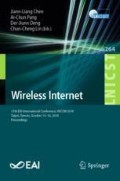Abstract
Energy saving is one of the most important issues for Internet of Things (IoT). An intuitive way to save energy of IoT devices is to reduce the reporting frequency to the IoT server. However, to do so, the time-variant values are distorted, which may be influential to the measured results. In this letter, we take PM2.5 application as an example to discuss the relation between energy efficiency and data accuracy. Through analyzing PM2.5 concentration collected via LoRa at National Chiao Tung University (NCTU) from 2016 to present, two reporting mechanisms based on timer and threshold, respectively, are proposed. The experimental results demonstrate that the threshold-based reporting outperforms the timer-based reporting by more than \(37\%\) in energy saving when the accuracies of these two reporting mechanisms are the same.
Access this chapter
Tax calculation will be finalised at checkout
Purchases are for personal use only
Notes
- 1.
PM2.5 is the suspended particulate matter smaller than 2.5 \(\upmu \)m in diameter.
- 2.
The maximum working power for PMS7003 is 100 mA \(\times \) 5 V\( = 0.5\) W at most. The RF power with 20dBm for GL6509 is 0.45 W. In other words, almost \(50\%\) of the device’s energy is consumed by the LoRa transmission.
- 3.
The observation period lasted 4 months with 174,240 sampled data (\(121\,days \times 24~h \times 60\,min \)). Figure 2 illustrates partial results.
- 4.
Error reversal is defined as an incident where the reporting accuracy obtained by a smaller timer is worse than that by a larger timer.
- 5.
Here, we only demonstrate the results where the packet loss probability is set to 0.5. The results with other packet loss probabilities are similar.
References
3GPP, Introduction of NB-IoT, TS 36.201 (2017)
LoRa Alliance. https://www.lora-alliance.org/lorawan-white-papers
Sigfox website. http://www.sigfox.com
Chang, C.-W., Chen, J.-C.: UM paging: unified M2M paging with optimal DRX cycle. IEEE Trans. Mobile Comput. 16(3), 886–900 (2017)
Chang, C.-W., Chen, J.-C.: Adjustable extended discontinuous reception (eDRX) cycle for idle-state users in LTE-A. IEEE Commun. Lett. 20(11), 2288–2291 (2016)
Liu, B., Yan, S., Li, J., Li, Y.: Forecasting PM2.5 concentration using spatio-temporal extreme learning machine. In: Proceedings of IEEE ICMLA, pp. 950–953 (2016)
Tang, M., Wu, X., Agrawal, P., Pongpaichet, S., Jain, R.: Integration of diverse data sources for spatial PM2.5 data interpolation. IEEE Trans. Multimedia 19(2), 408–417 (2017)
Chang,J.-H., Tseng, C.-Y.: Analysis of correlation between secondary PM2.5 and factory pollution sources by using ANN and the correlation coefficient. IEEE Access 5, 22812–22822 (2017)
Kumar, A., Kumar, A., Singh, A.: Energy efficient and low cost air quality sensor for smart buildings. In: Proceedings of IEEE CICT, pp. 1–4 (2017)
Reference withheld for double-blind review.
Gemtek IoT products web site. http://www.giotnetwork.com
Higgins, J.R.: Sampling theory in Fourier and signal analysis: foundations. Oxford Clarendon Press (1996)
Acknowledgment
This work was supported in part by the Ministry of Science and Technology (MOST) under Grant 106-2221-E-009-006, Grant 106-2221-E-009-049-MY2 and Grant 107-2218-E-009-049, in part by Academia Sinica AS-105-TP-A07, Ministry of Economic Affairs (MOEA) 106-EC-17-A-24-0619 and the Ministry of Education through the SPROUT Project Center for Open Intelligent Connectivity of National Chiao Tung University and Ministry of Education, Taiwan, R.O.C.
Author information
Authors and Affiliations
Corresponding author
Editor information
Editors and Affiliations
Rights and permissions
Copyright information
© 2019 ICST Institute for Computer Sciences, Social Informatics and Telecommunications Engineering
About this paper
Cite this paper
Chang, CW., Lin, YB., Chen, JC. (2019). Reporting Mechanisms for Internet of Things. In: Chen, JL., Pang, AC., Deng, DJ., Lin, CC. (eds) Wireless Internet. WICON 2018. Lecture Notes of the Institute for Computer Sciences, Social Informatics and Telecommunications Engineering, vol 264. Springer, Cham. https://doi.org/10.1007/978-3-030-06158-6_20
Download citation
DOI: https://doi.org/10.1007/978-3-030-06158-6_20
Published:
Publisher Name: Springer, Cham
Print ISBN: 978-3-030-06157-9
Online ISBN: 978-3-030-06158-6
eBook Packages: Computer ScienceComputer Science (R0)

